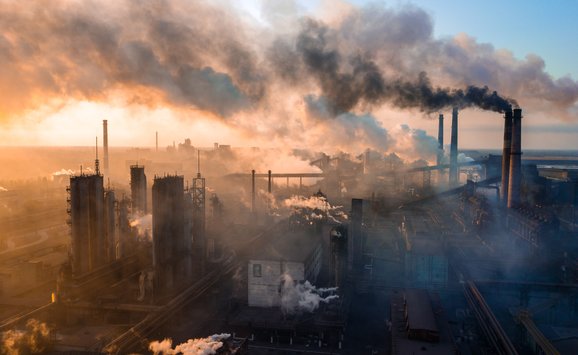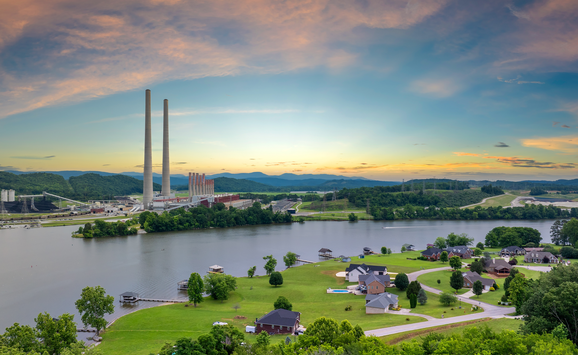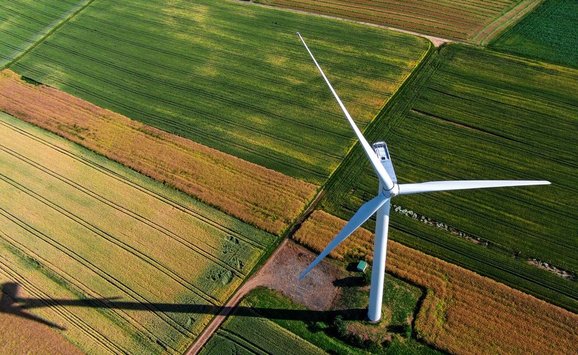Growing public acceptance of environmental quality as an important goal of national policy was reflected during 1971 in the number and variety of conflicts over specific issues. There was an increasing tendency to go to court, although recourse was also had to legislative and administrative action. In all three of these areas existence of the National Environmental Quality Act of 1970 often gave more leverage to defenders of the environment.
In most of the major contests purely environmental issues became intertwined with other considerations. The supersonic transport controversy, for instance, brought forth much discussion of possible damage to the upper atmosphere and the effects of sonic booms but economic questions also played important role when the Senate last summer defeated the proposed additional subsidy to Boeing.
Among the year's unresolved environmental skirmishes a handful that have interesting implications for the future are noted below.

Smoke at Four Corners. Power production in the Four Corners area, where Arizona, New Mexico, Utah, and Colorado meet, is generating environmental controversy as well as electricity. With two large coal plants already in operation, work on four more went forward in in the face of widespread opposition, which included legal action seeking to block further construction. Air pollution was not a national concern when in 1963 the first of the big plants began production in sparsely settled country far from any large city.
More recently, visibility has decreased and haze increased in the area. The principal blame for this is laid upon the very small fly-ash particles from the plants. These particles stay suspended in the atmosphere for long periods and are trapped in the natural basin between the Rockies and the Jemez mountains. The plants also emit large amounts of sulfur dioxide and nitrogen oxides.
The power companies are installing more efficient precipitators on the present plants in order to reduce the fly-ash emissions to roughly 10 percent of present levels. The construction of four more plants of similar size and with precipitators of similar efficiency would presumably result in emissions of about 30 percent of present levels. However, the question of just what levels might be reasonable is unresolved and involves not only completion of plants under construction but also longer-term expansion plants. Also in question are the possible effects of sulfur dioxide and nitrogen oxide emissions. In some of the areas using the power from Four Corners, notably Los Angeles, air pollution regulations would not permit the construction of such plants. Whether the effects of the emissions are similar in the two locations does not dilute the emotional argument.
Strip mining of coal on Black Mesa is also an issue, although currently of less concern than it is in the East. The different nature of the physical environment, the low population density, and absence of a long history of environmental outrages through stripping may be the reasons. Reseeding and landscaping of the mined area have been promised.
Thermal pollution does not appear to be a major issue at present, but other water problems are causing concern. For example, coal moves from Black Mesa to the Mohave generating plant through a coal slurry pipeline. To obtain the water for the slurry, 120,000 gallons per hour are pumped from deep wells on the Mesa. There is fear that these wells will eventually lower the water table and thus dry up tribal grazing land.
National environmental groups have joined those in the area opposing further development. The Department of the Interior has prepared environmental statements, as called for by law, on various aspects of the power development. However, these required statements deal with very limited aspects of the problem, such as transmission lines and railroad rights-of-way. In recognition of the need for a much broader look at the question of power and the environment in the Southwest, the Interior Department has organized a multi-agency group to conduct a study of the overall problem. The Environmental Protection Agency, the Council on Environmental Quality, the Federal Power Commission, the Atomic Energy Commission, and others are participating in a Southwest Energy Study, which is scheduled for completion within the next few months. The Secretary of the Interior does not plan to make any decision on new licenses until then.
Meanwhile, environmental groups and some local interests have entered suits against the Secretaries of the Interior and the Army in an effort to halt further construction of the power plant complex. (The Interior Department is involved because of its interest in Indian lands and part ownership, with the Navajo, of one of the generating plants. The Department of the Army is involved in some of the cases because of water rights.) Although the suits were originally brought in Washington, D.C., a federal judge in early fall allowed a motion to transfer them to the district court in Phoenix, which is much nearer to the site of the power plants. This transfer has the merit of making the hearings more accessible to those most closely involved. However, it will make it more difficult to use the environmentally oriented legal talent that is available in Washington. At the close of the year the plaintiffs were appealing the transfer of jurisdiction.

THE TRANS-ALASKA PIPELINE. Temporary injunctions granted in 1970 continued during 1971 to block construction of the proposed 800-mile pipeline that would carry oil south from Alaska's North Slope to Valdez on the Gulf of Alaska. But by the close of the year further developments in at least one of the cases appeared imminent.
In that action three conservation organizations sued the Secretary of the Interior to require publication of an environmental impact statement as called for in the National Environmental Policy Act. Last summer the Department of the Interior held public hearings on a draft impact statement, and subsequently began to prepare a final version whose publication is expected early in 1972. Meanwhile the plaintiffs have contended that publication will not meet the requirements of the act unless the statement includes analyses of (1) whether a route through Canada would be preferable and (2) the need for producing the North Slope oil in any case. Secretary Morton has disagreed with this view, so further litigation may follow.
In their suit the environmentalists cited danger of permafrost subsidence, impediments to wildlife migration, probability of pipeline breaks in areas of high seismic activity, and possible large oil spills in the waters of Prince William Sound. A second lawsuit has been brought by a group of Cordova fishermen who fear the increased tanker and terminal activity in Prince William Sound will seriously threaten their livelihood.
Thus the future of the Alaska pipeline still is doubtful. The oil companies, who are sitting on a major field of some 10 billion barrels of proven reserves in which they already have invested about a billion dollars, are anxious to bring the oil to market. If legal delays continue, the oil companies might as an alternative consider applying to the Canadian government for permission for an overland oil pipeline. They already have taken preliminary steps in regard to a natural gas pipeline. Either right of way might entail economic and political complications and would surely be scrutinized closely by conservationists.

MINERAL KING. In the Mineral King case, one aspect of which was before the Supreme Court at the close of 1971, the issue is between development for commercial recreation and preservation of wilderness values.
Mineral King is an area of some 15,000 acres comprising a high, narrow valley ringed by 12,000-foot peaks and alpine bowls in the Sierra Nevada Mountains of south-central California. Though part of the Sequoia National Forest, it is almost entirely surrounded by the Sequoia National Park.
In January 1969, the U.S. Forest Service approved a plan submitted by Walt Disney Productions for development of Mineral King as 3 year-round, high-density recreation complex, with particular emphasis on downhill ski facilities. The posed development was immediately opposed by the Sierra Club and others on grounds (1) that it would destroy existing wilderness, values, and (2) that the enlarged all-weather access road required through the Sequoia National Park would impair wilderness values there, and would in any case be illegal.
The Forest Service noted that the Sierra Club had itself consistently supported the development of ski facilities there. Replying that this support had been based on an assumed modest development, the Sierra Club took the matter to court, winning a preliminary injunction against the start of construction. In the fall of 1970 this decision was reversed by a U.S. Court of Appeals, on grounds that the club's general interest in conservation was insufficient to give it legal standing as sole plaintiff. The issue is now before the Supreme Court, which is expected to rule on the question of the Club's standing sometime in the spring of 1972. The ruling will have significant repercussions beyond the particular case, and on the environmental defense movement generally which has increasingly made use of litigation.
Opponents of the Disney-Forest project contend that Mineral King is ecologically part of the same Park, and should be given the same statutory protection. It was, in fact, initially excluded from the Park only because of a now defunct mining activity. Currently it is used by summer residents and larger numbers of hikers, campers, fishermen, and cross country skiers. As a wildlife refuge it is visited also by students of natural history. Though use in all these categories has been increasing rapidly in recent years, it is still small in comparison with that envisioned by the Disney project.
Proponents of the project point to the large and growing demand, especially in southern California, for ski and other developed recreation facilities that Mineral King is superlatively equipped to provide. It is asserted, moreover, that the presence in the valley of various structures associated with the current recreational and other uses, along with the evidences of the old mining operations—and the existing access road—make the area unfit for inclusion in the Wilderness System.
Not an issue in the current legal proceedings, but relevant from an economist's point of view, is the question of whether the benefits from an additional high-density recreation development of the sort proposed would outweigh the direct costs of its construction, including improvement of the access road, plus the values that would result from alternative use.

HELLS CANYON. The controversy over harnessing the last reach of free-flowing water in the Hells Canyon of the Snake River has been going on for nearly 20 years. The latest, but not the last, chapter in the long story was written last February when the Presiding Examiner of a Federal Power Commission hearing decided that a license for hydroelectric power should be issued subject to a five-year delay, during which the Middle Snake might be included in a federal land reservation as part of the National Wild and Scenic Rivers System or for park or recreation purposes.
Exceptions to the decision were entered by the applicants, as they were by the FPC staff counsel, who had recommended against development. At the close of the year the FPC itself had not acted upon the Presiding Examiner's decision. The Commission's action, whatever it may be, could be appealed to a federal court. If the Examiner's decision should stand, the future of Hells Canyon will depend upon whether Congress before February 1976 establishes it as a type of reservation that would preclude its use for water development. Various conservation organizations are pressing proposals to this end.
Hells Canyon is the deepest gorge in North America. Its ecology represents virtually all of the life zones found on the continent, providing habitat for a great variety of wildlife and fish. Some of the finest salmon and steelhead fishing is provided by this stream, and the primitive surroundings along with those of the adjacent Wallowa Mountains on the Oregon side provide the only truly wilderness big game hunting opportunities remaining in Oregon.
The present controversy had its origins in 1954, when the Pacific Northwest Power Company applied to the FPC for a license to build two low dams at Mountain Sheep and Pleasant Valley sites in Hells Canyon. In the complicated maneuverings that followed, the site proposals were modified; a rival application from the Washington Public Power Supply System was first denied by FPC and later consolidated with that of PNCP; and the Department of the Interior entered the case, first to propose development under its auspices, and later to oppose development for an indefinite period.
The Power Commission's subsequent granting of a license for development was appealed to the Supreme Court, which in 1967 remanded the case to FPC for further study of two issues: (1) whether development should be undertaken by the federal government or by private or non-federal public utilities, and (2) whether it would be in the public interest to inundate the remaining portion of the free-flowing river. The subsequent FPC hearing opened in September 1968 and the record was closed in March 1970. It was on the basis of this hearing that the Presiding Examiner's decision was presented last February.





